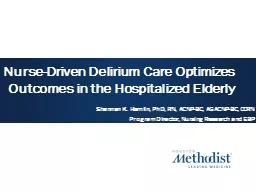

Shannan K Hamlin PhD RN ACNPBC AGACNPBC CCRN Program Director Nursing Research and EBP Acute confusional state with decline in cognitive functioning Fluctuating mental status inattention disorganized thinking ID: 909528
Download Presentation The PPT/PDF document "Nurse-Driven Delirium Care Optimizes Out..." is the property of its rightful owner. Permission is granted to download and print the materials on this web site for personal, non-commercial use only, and to display it on your personal computer provided you do not modify the materials and that you retain all copyright notices contained in the materials. By downloading content from our website, you accept the terms of this agreement.
Slide1
Nurse-Driven Delirium Care Optimizes Outcomes in the Hospitalized Elderly
Shannan
K. Hamlin, PhD, RN, ACNP-BC, AGACNP-BC, CCRN
Program Director, Nursing Research and EBP
Slide2Acute confusional state with decline in cognitive functioningFluctuating mental status, inattention, disorganized thinking Results from multiple factors
Medication side effects
DehydrationAcute illnessInfectionAcute neurologic event (i.e., stroke)
Background
Delirium
Definition
Slide3Delirium independent predictor poor outcomes with increased risk forM
ortality
DementiaInstitutionalizationLength of stay
Healthcare related costs
$164 billion in the U.S (Inouye et al., 2013)
Background
Predictor of Outcome
Slide4Delirium is most frequent complication in hospitalized elderly Up to 50% affected 40% cases classified as preventable complication
(Inouye et al., 2013)
Background
Significance
Slide5Significant public health relevanceDelirium ranks top 3 conditions in need of quality care improvement in the elderly (Arora et al., 2007)
National Quality Measures Clearinghouse of the Agency for Healthcare Research and Quality (AHRQ) states delirium in elderly
quality of care and safety marker
Background
Significance
Slide6Despite clinical relevance and significant economic impact, less 50% delirium in elderly recognized by clinicians (Kales et al., 2003)
Bedside nurses fail to recognize in 30% cases even when using validated delirium detection instrument
(Inouye et al., 2001; Rice et al., 2011)Background
Significance
Slide7Age is primary variable associated with deliriumFor e
very
year over age 65 increased risk for delirum (
Huai
et al., 2014)Gender data conflicting results (Elie
et al., 1998; Ahmed et al., 2014)
Significantly associated
(
Huai
et al.,
2014;
Fortini et al., 2013)Illness severity (APACHE score)Increase length of stayCo-morbid conditions Hypertension Cognitive impairmentKidney failureDiabetes
Background
Risk Factors
Slide8Physical and chemical restraints (McCusker
et al, 2001)
Poly-pharmacy, especially benzodiazepinesLaboratory values (i.e., low albumin) (Ahmed et al., 2014)
Delirium previous hospitalization
Impaired hearing/vision Limitations with activity (Moerman et al., 2012
)
History of falls
*Risk delirium increases with each predisposing factor
Background
Risk Factors
Slide9Accurate delirium assessment non-existent in acute (non-critical) care setting by physicians or nursesClinicians rely upon neurologic assessment with focus on orientation
to diagnose delirium
Lacks sensitivity and specificity in detecting deliriumPrevention is most effective strategy to improve outcomesRoutine
cognitive
specific assessment improves early delirium recognition leading to faster more effective interventions (Inouye et al., 1999)
Background
Delirium Assessment
Slide10Recognition best accomplished by routine, brief cognitive screening and astute clinical observation (Inouye et al., 1999)Nurses who spend most time with patients, best suited recognize subtle changes patient’s behavior that assist with early detection
Utilizing the bedside nurse as driver-of-change in the hospitalized elderly is unprecedented
Delirium programs across country utilize specific delirium interprofessional teams with specialized expertise in elder careNursing staff included as ancillary “assistance” to overall program (Inouye et al.,
2013)
Background
Delirium
Assessment
Slide11A brief, evidence-based, delirium specific assessment is conducted on acute-care patients ≥ 70 years every 12-hours by the bedside nurseA delirium screening tool was included in the electronic medical record as part of the nursing assessment
Delirium assessment results positive → nurse initiates the Delirium Acute-Care Nursing Interventions Protocol and leads coordination of interprofessional delirium interventions
Nurse-Driven Delirium Initiative
Slide12Based on the Hospital Elder Life Program Cognitive impairmentSleep deprivation
Immobility
Visual impairmentHearing impairmentDehydration
Delirium Acute-Care
Nursing Interventions
Slide13Central to the initiative is early recognition of warning signs
Facilitates timely diagnosis and management
Targeted interventions with rapid resolutionNurses as largest, consistent care providers best suited to influence the continuum of delirium care from recognition to resolutionActive vigilance is the key to success
Delirium Acute-Care
Nursing Interventions
Slide14Fall reduction of 28.6% (25.9 to 18.5) in delirium screened patients compared to pre-intervention falls data
Outcomes
Falls
Slide1514.5% reduction in the mean length of stay (1.05 days) for positive delirium screened patients
Outcomes
Length of Stay
2013
Slide16Steady increase (34% average increase 2013) in number patient’s screened delirium positive who were discharged home rather than new institution (i.e., skilled facility)
Outcomes
Discharge Location
Slide17A focus on active vigilance for early identification of at-risk delirium patients, significantly affects quality and safety measures
A
proactive approach to address amendable risk factors and timely, but consistent strategies yields improved outcomes
Our n
urse-driven Delirium Initiative has demonstrated that nursing is well positioned to lead and resolve complex patient care issuesConclusions
Slide18Nurses can should lead and not following in quality and safe care for patients
By leading initiative to bring innovation and evidence-based practice to the bedside, we are demonstrating the impact of nursing
Institute of Medicine’s directive for nurses to practice to the full extent of their training and to act as a “critical factor in determining the quality of care in hospitals and the nature of patient outcomes”
(IOM, 2011, p. 92)
Implications for Practice
Slide19I don’t think there is any other quality so essential to success of any kind as the quality of perseverance. It overcomes almost everything, even nature.
John D. Rockefeller
Slide20